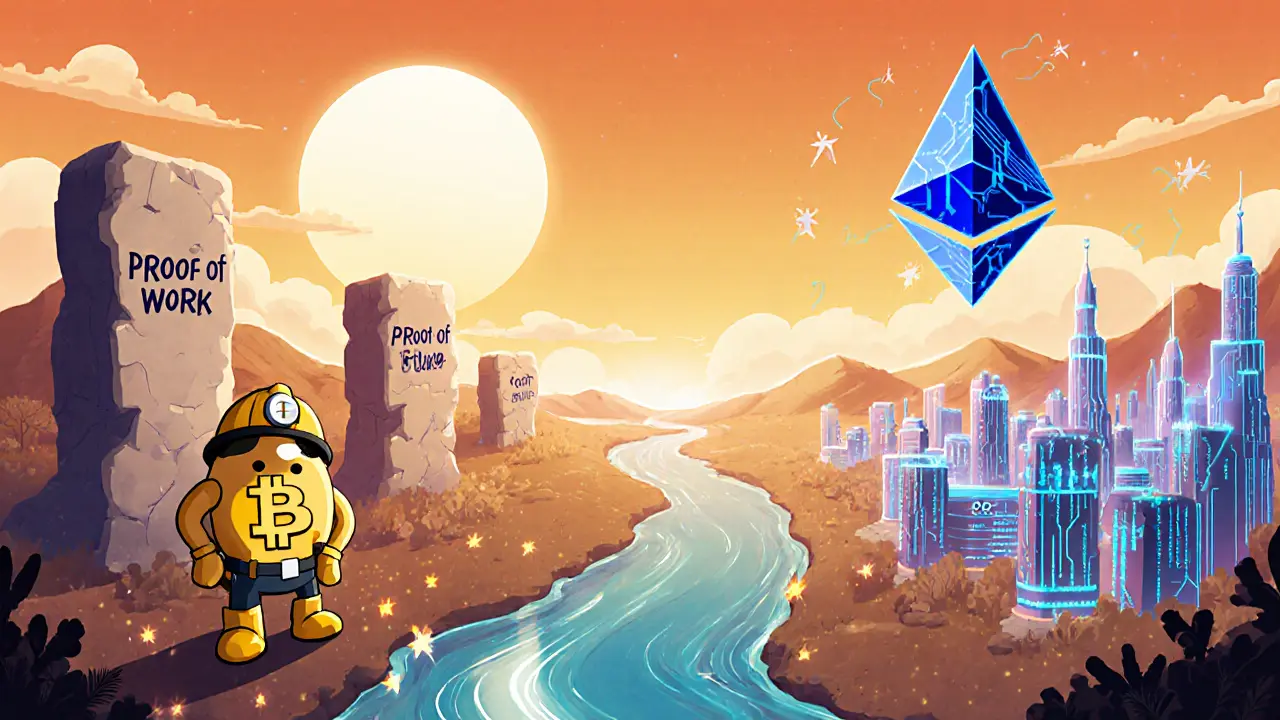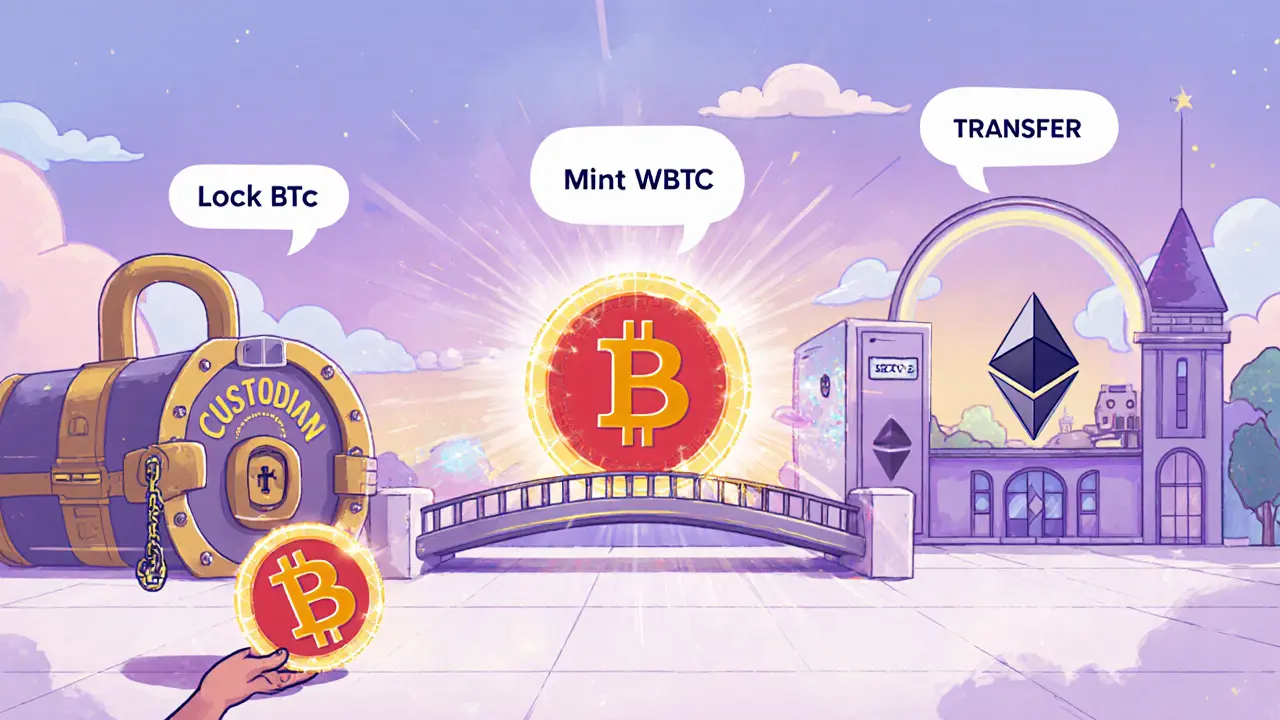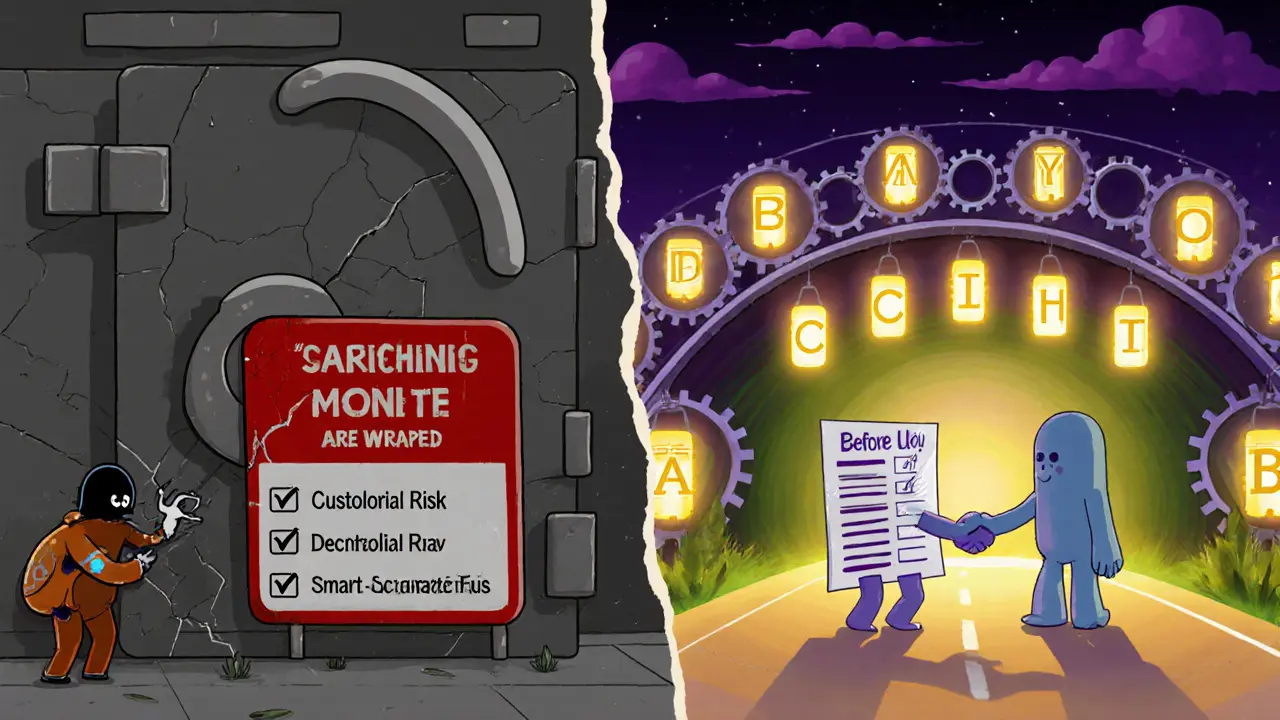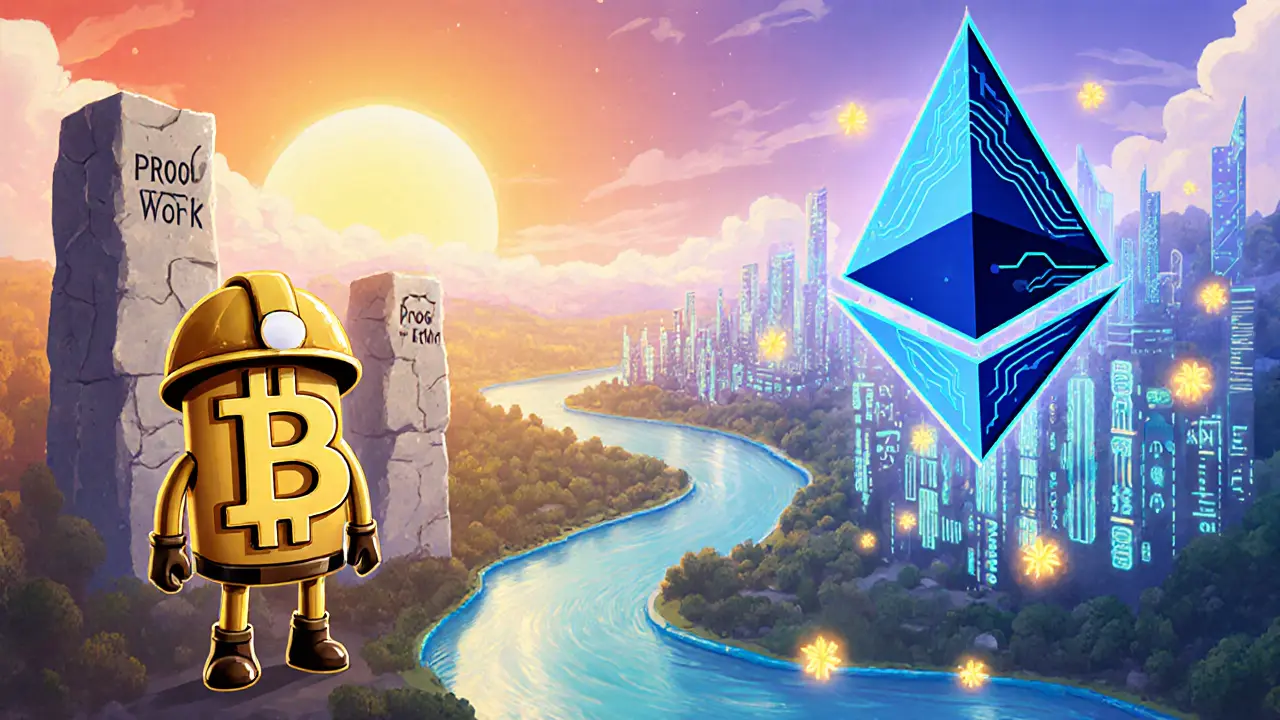 Dec, 4 2024
Dec, 4 2024
Wrapped Token Cost Calculator
Calculate Your Wrapped Token Costs
Ever wondered why your Bitcoin can suddenly appear on an Ethereum‑based app? The trick lies in wrapped tokens, a clever workaround that lets assets hop across blockchains while staying tied to their original value. But the original coins-known as native tokens-still play a distinct role in their own ecosystems. Understanding how these two classes differ is essential for anyone dipping toes into DeFi, cross‑chain trading, or multi‑chain portfolio management.
What Is a Native Token?
When a blockchain is built, it usually issues its own Native Token is defined as the original cryptocurrency that lives on the chain’s own ledger, secures the network and fuels its native protocol. Bitcoin (BTC) on the Bitcoin network and Ether (ETH) on Ethereum are classic examples. These tokens serve three core purposes:
- Pay transaction fees (often called gas).
- Reward validators or miners who keep the chain honest.
- Enable governance, staking, and other protocol‑specific features.
Because they are baked into the blockchain’s consensus rules, native tokens inherit the full security of the network. No extra contracts, no custodians-just the decentralized validator set.
What Is a Wrapped Token?
When a blockchain asset is Wrapped Token is defined as a digital representation of a native cryptocurrency on a non‑native blockchain, preserving a 1:1 value parity, it can move across chains while still tracking the original asset. The most famous example is Wrapped Bitcoin (WBTC), an ERC‑20 token on Ethereum that mirrors BTC 1:1. Other popular wraps include Wrapped Ether (WETH) for ERC‑20 compatibility and WAVAX for bringing Avalanche’s AVAX onto Ethereum.
The wrapping process typically follows these steps:
- User sends the native asset (e.g., BTC) to a custodial vault or a DAO‑run smart contract.
- The vault locks the asset on its home chain.
- An equivalent amount of the wrapped token is minted on the target chain.
- The wrapped token is transferred to the user’s wallet on that chain.
- To redeem, the user sends the wrapped token back, the contract burns it, and the custodian releases the original asset.
This workflow creates a bridge between isolated ecosystems, allowing Bitcoin holders to lend on Aave, stake on Compound, or swap on Uniswap without ever selling their BTC.

Security and Trust: Custodians vs Consensus
Native tokens rely on the consensus algorithm-Proof‑of‑Work, Proof‑of‑Stake, or variants-to secure the ledger. That means thousands of independent nodes validate every transaction. Wrapped tokens, however, add an extra trust layer. The underlying asset sits in a vault managed by a custodian (often a company like BitGo) or a decentralized DAO contract. If the custodian is compromised, the wrapped token can lose its 1:1 backing.
Industry researchers have highlighted this risk. A 2023 ConsenSys report called wrapped tokens a “systemic risk through centralized points of failure.” Meanwhile, Vitalik Buterin has noted that they “introduce additional trust assumptions that go against the spirit of decentralization.” On the flip side, projects like Chainlink’s Cross‑Chain Interoperability Protocol (CCIP) aim to replace custodial models with fully decentralized escrow contracts, mitigating the single‑point‑of‑failure concern.
Practical Use Cases in DeFi
Why bother with the extra steps? Because most DeFi protocols on Ethereum, Binance Smart Chain, or Polygon accept only ERC‑20 tokens. Native ETH cannot be supplied directly to a lending pool that expects an ERC‑20; WETH solves that by conforming to the standard while still representing ETH 1:1. Likewise, Bitcoin holders can earn interest on Aave or provide liquidity on Uniswap by using WBTC, unlocking capital that would otherwise sit idle on the Bitcoin chain.
Data from Dune Analytics shows that, as of September 2023, about $5.2 billion of Bitcoin’s market cap was locked in Ethereum DeFi through WBTC alone. That figure underscores how wrapped assets have become essential plumbing for the multi‑chain economy.

Side‑by‑Side Comparison
| Aspect | Wrapped Token | Native Token |
|---|---|---|
| Native Chain | Issued on a foreign chain (e.g., Ethereum) | Issued on its own blockchain (e.g., Bitcoin) |
| Token Standard | Follows target‑chain standard (ERC‑20, BEP‑20, etc.) | Follows its own protocol rules |
| Security Model | Depends on custodian or DAO contracts for collateral | Secured directly by the network’s consensus |
| Liquidity Scope | Accessible on any dApp that supports the target standard | Limited to native ecosystem unless bridged |
| Redemption Process | Must be unwrapped through a custodian, incurring gas and time | Can be transferred instantly without extra steps |
| Typical Use‑Case | Participate in DeFi on another chain, cross‑chain swaps | Pay fees, stake, govern, secure the network |
Risks, Pitfalls, and How to Mitigate Them
While the upside is clear, wrapped tokens bring three major risks:
- Custodial risk: If the vault’s private keys are stolen, the underlying asset disappears.
- Redemption latency: Unwrapping can take minutes, especially on congested networks.
- Smart‑contract bugs: A flaw in the wrapping contract could allow malicious actors to mint fake tokens.
Mitigation tips:
- Prefer decentralized custodians (e.g., RenVM, Uniswap’s v3 bridge) over single‑entity vaults.
- Check audit reports-look for firms like CertiK or OpenZeppelin.
- Keep gas fees in mind; unwrapping on Ethereum can cost $1‑$2 on busy days (Etherscan average Sep 2023).
- Always verify token contract addresses on official docs; typo‑squatting is a common loss vector.
Community sentiment reflects these concerns: an August 2023 Crypto Twitter poll showed 68 % of respondents preferred native assets when available, citing security worries.

Future Outlook: Will Wrapped Tokens Remain Relevant?
Several trends could reshape the landscape:
- Native cross‑chain messaging: Ethereum’s upcoming EIP‑3668 may allow native ETH to be used directly in DeFi without WETH, reducing the need for wrappers.
- Decentralized custody solutions: Chainlink’s CCIP and emerging DAO‑run bridges aim to eliminate single custodians, addressing the biggest risk factor.
- Regulatory pressure: The U.S. OCC guidance (2023) treats custodians of wrapped assets like traditional custodians, potentially adding compliance overhead.
Analysts at Gartner predict that wrapped assets will still account for roughly 18‑22 % of cross‑chain value transfer through 2027, then taper off as native interoperability protocols mature. For now, they remain a critical piece of the multi‑chain puzzle, especially for retail users who want to earn yield on Bitcoin without leaving the Ethereum ecosystem.
Quick Checklist Before You Wrap
- Identify the target chain and required token standard (e.g., ERC‑20).
- Choose a reputable wrapping service-look for audits and community reviews.
- Confirm the contract address on the official website.
- Estimate gas fees for both wrapping and unwrapping.
- Test with a small amount first to ensure the process works as expected.
What’s the main difference between a wrapped token and a native token?
A native token lives on its own blockchain and is secured by that chain’s consensus. A wrapped token is a representation of that native asset on a different blockchain, following the target chain’s token standard and relying on a custodian or smart contract for the 1:1 backing.
Do I need to pay gas fees to wrap a token?
Yes. Wrapping involves a transaction on the source chain to lock the asset and another on the target chain to mint the wrapped token. As of September 2023, an Ethereum minting transaction averaged $1.27 in gas.
Can I unwrap a token instantly?
Unwrapping requires the custodian to burn the wrapped token and release the native asset. This can take from a few seconds to several minutes, depending on network congestion and the custodian’s processing time (average 22 minutes for many services).
Are wrapped tokens safe to use in DeFi?
They are safe when you choose audited contracts and reputable custodians. However, they add a layer of trust beyond the native blockchain, so always assess the custodian’s reputation and avoid unverified bridges.
What are the most popular wrapped tokens today?
WBTC (Wrapped Bitcoin), WETH (Wrapped Ether), and WAVAX (Wrapped Avalanche) dominate the market, together representing over $10 billion in total value locked across DeFi platforms.
Scott McCalman
December 4, 2024 AT 17:42Wow, this deep‑dive just blew my mind! 🎉 Wrapped tokens are the superhero side‑kicks to native coins, letting us hop across blockchains without losing our precious assets. It’s like the DeFi version of “bring your own device” – you just plug in Bitcoin and watch it work on Ethereum. The article nailed the basics, but let’s not forget the hidden fees that can sneak up on you like a ninja. 😊
PRIYA KUMARI
December 5, 2024 AT 07:35Honestly, the piece glosses over the biggest problem: custodial risk. The whole “clever workaround” narrative is a smokescreen for centralized points of failure that can be exploited at any moment. Anyone who thinks this is “just a bridge” is dangerously naive.
Jessica Pence
December 6, 2024 AT 00:15Great explination! I think it’s important to note that when you lock BTC in a vault the transaction fee on Bitcoin can be higher than you expect, so always check the fee estimator before you start. Also, double‑check the contract address on the official site-typos can cost you dearly.
johnny garcia
December 6, 2024 AT 19:42From a theoretical standpoint, the dichotomy between native and wrapped tokens reflects a broader ontological split in the blockchain ecosystem: the immutable substrate versus its mutable representation. By leveraging wrapped assets, we extend the universality of value across divergent consensus layers, fostering a meta‑network of liquidity. 🌐
Andrew Smith
December 7, 2024 AT 06:48Spot on! 🎉 Adding wrapped tokens really does open up a world of opportunities for the average user. It’s awesome to see how these bridges let us earn yield without selling our original coins.
Ryan Comers
December 8, 2024 AT 07:48Hold up, folks! All this hype about “interoperability” is just a distraction from the real issue – us losing control of our sovereign assets to foreign code. If we keep feeding our national crypto into foreign bridges, we’re basically handing over our financial independence. 🇺🇸🚀
Prerna Sahrawat
December 9, 2024 AT 17:08The discourse surrounding wrapped tokens, when examined through the prism of contemporary financial epistemology, reveals an intricate tapestry of both promise and peril, one that is seldom captured in cursory overviews. First, one must appreciate that the very act of wrapping transforms an intrinsically singular asset into a fungible placeholder, thereby subjecting it to the vagaries of a secondary consensus mechanism. This metamorphosis, while conceptually elegant, engenders an additional vector of systemic risk that manifests whenever the custodial contract is either compromised or suffers from a governance malfunction. Moreover, the reliance on centralized vaults, despite their ostensible efficiency, subtly reintroduces the very custodial hierarchies that decentralized finance purports to eliminate. In practice, the user experience is further muddied by fluctuating gas costs, which can erode the purported yield advantage of using wrapped assets. The audit landscape, too, is fragmented; while some contracts receive pristine attestations from firms such as CertiK, others languish without any formal scrutiny, creating an uneven security baseline across the ecosystem. Empirically, the capital locked in wrapped Bitcoin alone surpassed five billion dollars as of late 2023, a figure that underscores both the utility and the concentration of risk inherent in such instruments. From a regulatory perspective, the United States Office of the Comptroller of the Currency’s guidance effectively treats custodians of wrapped assets as de facto financial intermediaries, thereby exposing them to a suite of compliance obligations previously reserved for traditional custodians. This regulatory overlay could, in turn, precipitate a chilling effect on innovation, as developers grapple with the added overhead of legal conformity. On the brighter side, emerging protocols such as Chainlink’s Cross‑Chain Interoperability Protocol aspire to supplant custodial models with fully decentralized escrow mechanisms, a development that could materially mitigate the single‑point‑of‑failure concern. Nevertheless, the transition to such architectures will demand rigorous testing, community consensus, and perhaps most challengingly, a paradigm shift in user trust assumptions. In sum, while wrapped tokens undeniably expand the functional horizon of DeFi, they simultaneously compel participants to navigate a labyrinth of technical, economic, and legal intricacies that demand a sophisticated level of due diligence. Only by acknowledging and addressing these multifaceted challenges can the community hope to realize the full transformative potential of cross‑chain liquidity.
Joy Garcia
December 10, 2024 AT 01:28Reading that, I can’t shake the feeling that the whole “decentralized bridge” narrative is a clever smokescreen orchestrated by the elites to keep us dependent on hidden backdoors. Every time a new protocol claims “no custodial risk,” there’s a silent clause somewhere granting secret access to big‑tech proxies. Stay vigilant, the truth is buried in the fine print.
mike ballard
December 10, 2024 AT 23:42In the broader context of blockchain interoperability, the abstraction layer provided by wrapped tokens serves as a lingua franca, enabling heterogeneous networks to communicate without sacrificing native protocol semantics. Think of it as a universal adapter for the crypto ecosystem – plug‑and‑play, but with a dash of technical nuance. 😊
Molly van der Schee
December 11, 2024 AT 10:48You’re absolutely right, the analogy of an adapter really helps demystify the concept for newcomers. It’s encouraging to see such clear explanations that bridge the gap between intricate tech and everyday understanding.
Mike Cristobal
December 12, 2024 AT 00:42Remember, trusting a single custodian with your assets is a shortcut to financial ruin. 😇
Erik Shear
December 12, 2024 AT 17:22We can all agree that bridges have pros but also cons keep the discussion civil
Tom Glynn
December 13, 2024 AT 01:42Indeed, the key is balance – embracing innovation while maintaining rigorous safeguards. 🌱
Johanna Hegewald
December 13, 2024 AT 21:08For anyone just starting out, always double‑check the contract address and start with a small amount to test the wrap and unwrap process.
Benjamin Debrick
December 14, 2024 AT 08:15While the advice is fundamentally sound; one must, however, underscore the imperative of performing due diligence with a level of scrutiny that borders on academic rigor; otherwise, the casual practitioner risks irrevocable loss; thus, a meticulous approach is not merely advisable but essential;
Anna Kammerer
December 15, 2024 AT 00:55Sure, because who doesn’t love spending half an hour hunting down the right contract address before they can actually do anything useful? It’s like a treasure hunt, except the treasure is your sanity.
Mike GLENN
December 15, 2024 AT 14:48I’ve seen many newcomers get tripped up by the extra steps involved in wrapping and unwrapping, so a practical tip is to keep a checklist handy: confirm the target chain, verify the bridge’s audit report, note the gas fees, and finally, test with a minimal amount. This systematic approach not only minimizes risk but also builds confidence, making the whole process feel less like a gamble and more like a calculated move in a larger strategy.